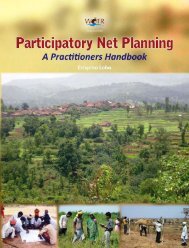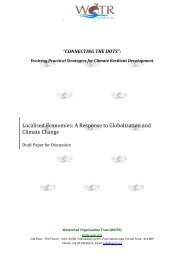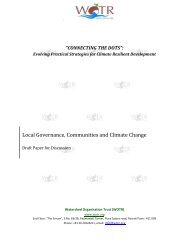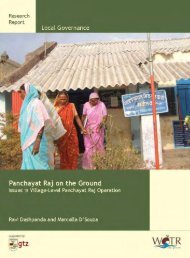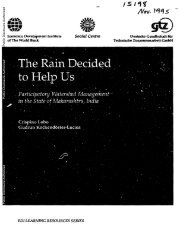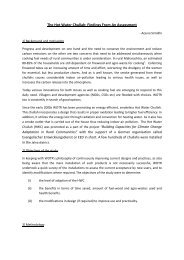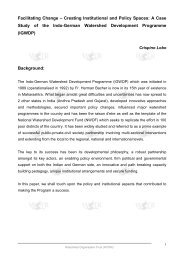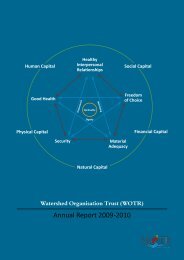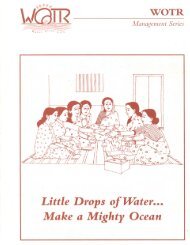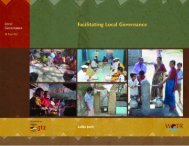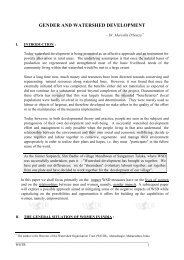Create successful ePaper yourself
Turn your PDF publications into a flip-book with our unique Google optimized e-Paper software.
t Hot off the Press!<br />
Food &<br />
Nutrition<br />
Security<br />
WOTR’s Position Paper<br />
Connec ng the Dots<br />
Evolving Prac cal Strategies for<br />
Adapta on to Climate Change<br />
Ecologic<br />
- A WOTR Newsle er<br />
...because Food is about agriculture, about ecology,<br />
about (wo)man's relationship with nature ...<br />
about nation-building, cultural struggles,<br />
friends and enemies<br />
and at times, even about sex...
Contents<br />
4<br />
6<br />
8<br />
10<br />
16<br />
18<br />
22<br />
Food Talk<br />
Lifestyle of Food<br />
Cooking up Empowerment<br />
FOOD & NUTRITION SECURITY<br />
IN A CHANGING CLIMATE<br />
The Right Food is not Child’s Play<br />
Disappearing Delicacies<br />
Ficus Focus<br />
HAPPY<br />
BIRTHDAY WOTR!<br />
WOTR completed 19 years since its incep on in December 1993. As it stepped into its 20th<br />
year of service to marginalized and vulnerable communi es, we@WOTR reiterate our<br />
commitment to our vision of equity, rejuvena ng ecosystems, and working towards bringing<br />
Posi ve Change.
EDITORIAL<br />
Food is about agriculture, about ecology, about (wo)man's rela onship with nature ... about na on-building,<br />
cultural struggles, friends and enemies ... and at mes, even about sex said the food expert Mark Kurlansky.<br />
And he couldn't have been more right. In our own experiences, upon deep reflec on, we see that food for<br />
mind, food for the body, and the food for spirit drive the human struggle for meaningful existence.<br />
As we step into 2013, having survived the 2012-hoo-ha about a world coming to an end (chuckle), we celebrate<br />
Makar Sankran , celebrated every year on the 14th of January. It marks the beginning of the harves ng<br />
season. Celebrated as a season of plenty, a season connected intrinsically with Food, this fes val has various<br />
names all over the country. Pongal in Tamil Nadu, Bhogali Bihu in Assam, Maghi in Haryana, Shishur Saenkraat<br />
in the Kashmir Valley and Pithey in Bengal. (Aside: Archeological surveys also reveal that the Mayans also<br />
celebrated a similar kind of fes val <strong>–</strong> which would make it a 6000-year-old style of celebra on!).<br />
Our Newsle er celebrates this me along with the food-growers (and the food-consumers !)all over the world<br />
by focussing upon this very basic need <strong>–</strong> FOOD <strong>–</strong> as we step into the 20th year of our existence as an<br />
organisa on. We bring you a baske ul of goodies <strong>–</strong> our very own Posi on Paper on Food & Nutri on Security,<br />
socio-cultural reflec ons on food, how food can become a vehicle of empowerment… and not to miss <strong>–</strong> a local<br />
recipe!<br />
A Happy New Year to you… may this year be a body, mind, and spirit fulfilling one for one and all.<br />
- Editor<br />
LOCAL WEATHER SPECIFIC AGRO-ADVISORIES BY SMS<br />
WOTR started its 20th year with a bang by disseminating Local Weather specific Agro-advisories by SMS to<br />
the farmers under its Climate Change Adaptation project. This pilot is being conducted with 100 farmers of<br />
Sangamner and Akole Taluka, Ahmednagar District, Maharashtra.<br />
WOTR's first Local weather specific agro-advisory was sent out at 5.14 pm on December 20, 2012 for the<br />
tomato growers of Warudhi Pathar and Sarole Pathar, Sangamner Taluka, for control of red mites. The<br />
SMS advised the farmers of spraying Neem seed kernel extract (NSKE) to control the pesky mites which<br />
are the bane of every tomato farmer. WOTR also disseminated agro-advisories through SMS for other<br />
crops with the advice for controlling onion blight, Wheat crop - advice for correct application of<br />
irrigation and pest control with NSKE and Sorghum crop - advice for appropriate irrigation.<br />
We will soon be bringing you more news... as to how the farmers feel about this service and how they apply it…<br />
so stay tuned.
4<br />
FOOD TALK<br />
- Shweta Radhakrishnan<br />
“Food functions metaphorically as a bridge across the borders of cultural communities.”<br />
-Van den Berghe<br />
As we rumbled into Khandgedara, I suddenly thought of the Swiss structuralist, Ferdinand de<br />
Saussure. No, he was not like your kindly neighbourhood uncle and no, the kaka (old uncle) on the<br />
cycle did not remind me of him. But as I was about to enter a village whose language was alien to me,<br />
Saussure came to mind. He has wri en reams about how language and our experience of the world<br />
are interconnected. He postulates that language not only equips us to describe what we see around<br />
us, it ac vely constructs the world around us. Without a word for a par cular thing or emo on, we<br />
probably wouldn't know it fully or be able to share it. His theory posits that “Psychologically our<br />
thought - apart from its expression in words - is only a shapeless and indis nct mass." The lack of a<br />
word in a certain language signifies that the community that speaks the language has not<br />
experienced it enough to construct a word or define it linguis cally. Consequently, it is difficult for an<br />
outsider to grasp an idea that is put forth in a language he doesn't understand and one that cannot be<br />
translated into his own.<br />
I remembered Saussure's ominous words as our jeep screeched to a halt in the dusty, li le village.<br />
The minute we stepped off the jeep, we were greeted by Marathi words and phrases and<br />
immediately I felt I like I had ended up next to the Tower of Babel. To be surrounded by a language<br />
that you cannot fully comprehend or really par cipate in is quite an unse ling feeling. Not only are<br />
you handicapped when it comes to communica ng with people, you also feel helpless at being<br />
unable to understand the finer nuances of their culture which are so aptly expressed in their<br />
language. As we trudged along to keep our bags in a house, I smiled weakly at anybody who spoke to<br />
me in Marathi and said apologe cally, “Mala Marathi maith nai.” (I don't know Marathi.)<br />
Later in the day, during dinner, the lady si ng next to me enquired whether I liked the food by<br />
poin ng at the food and supplemen ng her words with gestures. Suddenly I felt I shared some<br />
common ground with her. Through a series of gestures and some transla ons by my friends, I<br />
enthusias cally told her I really liked the food and that it was truly wonderful. Having communicated<br />
that, I felt a lot less lost than before.<br />
Food for me became an important point of interac on with the men and women in the village. Over<br />
the course of this trip, I began to follow the language be er when people spoke slowly or used words<br />
that were similar to Hindi words. But I was never able to connect with people be er than I was able to<br />
over a meal. Meals were a highlight of the trip, simply because here was a tangible product of an idea<br />
they were trying to put forth in their language. Food is a material manifesta on of a community's<br />
culture. Unlike language where you have to know the system of signs and meanings to understand<br />
the cultural system it sets up, food sets up a more immediate engagement with a community's<br />
culture. Which is why in many ways, food helped me overcome the language barrier in the villages<br />
and which also explains why the only words I know in Marathi all pertain to food. In every village that<br />
we went to, I think I felt completely at ease with the women during a meal. They also probably felt<br />
more comfortable asking me about food. “More bhaji ?” "Is the dish too spicy for you?” “Do you like<br />
the Bhakri here?” Since they knew I wasn't a Maharashtrian, they knew that their typically<br />
Maharashtrian dishes would be a novelty for me. But there was also the fear that my posi on as an
'Other' would be reaffirmed by my rejec on of their cuisine and they would always ask me anxiously<br />
if I liked the food. At those mes, I would hasten to assure them, food stuffed in my mouth, that I<br />
genuinely enjoyed their food. A lot of mes, I was able to forge a connect with the women solely<br />
because I was able to point out that where I came from (Kerala) we too consumed the same<br />
vegetable or how a certain dish was very similar to a dish in Kerala. And they would smile and look<br />
happier that I was comfortable with their food. They were also curious about how a community so far<br />
away could create a dish that bore any resemblance to any dish they cooked. This helped in star ng<br />
some sort of dialogue and interac on with the women and helped me to get a peek into their life and<br />
culture, if only for a brief moment. Food opened the door to a culture that Saussure had predicted I<br />
would probably be unable to access through language alone.<br />
5
6<br />
A LIFESTYLE OF FOOD AND A FOODSTYLE FOR LIFE…<br />
- Radhika Murthy (with inputs from Shweta Radhakrishnan)<br />
How different communi es use their available resources to produce indigenous cuisines is really a<br />
study in adapta on and evolu on of human culture. So much of food is culture. Our culture<br />
dictates our ingredients, our preferences, the way we consume food and also constructs binaries<br />
of what is acceptable and unacceptable within a cuisine.<br />
But people live to eat, eat to live and do everything in between too. Food in its various forms is a<br />
con nuum between survival and affluence. Our lifestyles dictate our food <strong>–</strong> amount, content and<br />
quality <strong>–</strong> and o en food is an indicator of life- climate, resources and culture in a par cular area.<br />
The economics of food has a lot to do with the development of any cuisine. The ability to<br />
purchase certain ingredients is of course an essen al component of what gets included or<br />
excluded from a cuisine.<br />
In Shiswad, a tribal village in the Akole Taluka (a block within Ahmednagar district), black tea<br />
heavily flavoured with lemongrass is o en served, because milk is a luxury here.<br />
But whether with or without milk, tea in rural areas is usually saccharine sweet. This can be<br />
because many people here are engaged in hard, physical labour and need a high sugar intake.<br />
Methi (fenugreek) is made as a gravy dish (Methichi paatal bhaaji) rather than a dry dish here,<br />
because methi tends to shrink when fried, thereby greatly reducing the quan ty that can be<br />
served. However, when cooked in gravy, the volume is greater and the dish can be served to more<br />
people.<br />
It is no ced that people in poorer socie es also tend to eat more spicy food. Ea ng spicy food<br />
tends to sa sfy one sooner and eat less. The other side to this is that many dhabas (highway<br />
restaurants) in India serve almost unbearably spicy food. This is because most of their clientele<br />
are truck drivers and labourers, who consume a lot of gutkha and tobacco in various forms.<br />
Excessive consump on of gutkha / tobacco dulls taste buds to such an extent that moderately<br />
spiced food seems tasteless and bland.<br />
In rural India, changing cropping pa erns in agriculture have turned demand and consump on of<br />
certain foodstuffs topsy-turvy. Millets, called poor man's grain, required fewer resources to grow<br />
compared to rice and wheat, used to be a staple in Maharashtra. Millets are richer in fibre<br />
(needed for hard labour) and grow more easily than wheat in this region. Bhakri, a flatbread<br />
made with coarser millets like jowar (sorghum), ragi (finger millet) and bajra (pearl millet) used to<br />
be eaten by all. Wheat chapa s belonged to the rich and urban classes.<br />
But the green revolu on and higher demand for wheat in ci es has made cul va ng wheat for<br />
urban markets more economically viable. Farmers get cash, albeit falling into the unsustainable<br />
cycle of hybrid seeds, chemical fer lisers, pes cides and reducing soil health. So, wheat chapa s<br />
are now a norm in Maharashtra's village too and millets, the erstwhile poor man's grain is now<br />
costlier than wheat! Market driven trends in farming do bring in cash-affluence in places. But it<br />
1 Cook Et Al., I. "Geographies of Food: following." Progress in Human Geography 30.5 (2006): 655-66. SAGE. Web. 15<br />
May 2011.
also brings in trends like cash crop cul va on and mono cropping which ul mately makes food<br />
consump on more market-dependent and less diverse. The effects on food and nutri on security<br />
are percep ble.<br />
Quite o en, the inclusion of outside food products in one's daily meal is a dis nct sign of<br />
affluence. The material display of one's ability to go beyond what is immediately available and<br />
procure what one wants from somewhere else is apparent when there shops in villages selling<br />
foodstuffs produced outside. In the rela vely prosperous Akole villages of Khadki Budruk and<br />
Malegaon Pathar, store-bought pickles, poppadom and a generous sprinkling of coconut on the<br />
pohe (breakfast made out of fla ened rice, onions and peanuts) are all tell-tale signs of affluence.<br />
These are indulgences affordable only when one has a certain economic and social standing. In<br />
comparison, Shiswad has a ra on store, while Khandgedara has a small makeshi store mainly<br />
selling soap and chocolates. Khadki and Malegaon, on the other hand, have bigger shops which<br />
stock varied food items and city 'brands'.<br />
The greater the exposure to outside products, the greater the desire to imitate them. In many<br />
villages there is a more localized version of Rasna (a popular Indian instant drink mix), morphed<br />
into Ras Hai Na and Ras Pi Na. This powder, manufactured in Madhya Pradesh, is now available in<br />
most villages here. It is served on special occasions to indicate the affluence of the family to<br />
guests.<br />
A small digression into the way people eat brings in another angle to food culture. A comparison<br />
of dining spaces and the economic condi on of villages in Akole gives the impression that<br />
segregated and more individualized dining spaces are the result of greater material affluence and<br />
'development'. Tradi onally, people eat in the kitchen as a family and in the living room or even<br />
outside in the yard if the house is too small for guests. Musing on a more global level, fast food<br />
like burgers or sandwiches, is an all-in-one, single-person meal. It is designed in such a way that it<br />
is not always easy to divide and share with others. Tradi onal food <strong>–</strong> rice, chapa s, vegetables, on<br />
the other hand, is served in helpings and can be easily shared, if someone happens to walk in<br />
during meal me.<br />
Food can thus effec vely reflect social changes brought about by material affluence and market<br />
incursions. But does access to markets mean everyone ea ng the same food? Is that food the<br />
right, nutri ous food? It is interes ng that the trend among the urban elite of shi ing to 'organic,<br />
raw, healthy' foods and the rural trend towards packaged, processed, 'urban' foods are both<br />
linked to lifestyle and markets. The key is to strike the right balance between current food<br />
'fashions' and essen al nutri on.
8<br />
COOKING UP<br />
EMPOWERMENT<br />
In the classical feminist picture, the woman needed to step out of home, specifically out of the<br />
kitchen and take up a job, so that she could also be economically independent like men. The<br />
kitchen entombed women in shackles of housework.<br />
So a certain class of women feel that libera on for them means freedom from the kitchen and all<br />
that it signifies - freedom from being solely (o en thanklessly) responsible for the food<br />
department in the house.<br />
This thinking is the logical outcome of centuries of patriarchy in which all work related to house<br />
and hearth is secondary and therefore the woman's preroga ve as the weaker sex.<br />
Patriarchy confined women in the kitchen, but fi ngly, it is in the kitchen that thousands of rural<br />
women are cooking up their independence and freedom. The kitchen is now the new powerhouse<br />
for women and food is their power.<br />
Today, in the rural Indian context, at a superficial level, almost nothing's changed. Men work, or don't<br />
work, depending on the level of their addic ons. The woman cooks and cleans, fetches water and<br />
firewood and provides what the family needs, o en even financially, but only doing jobs women are<br />
'allowed' to do. She doesn't par cipate in important decision making, especially not in poli cs. There<br />
is no such thing as equality between the sexes; typical gender roles are unques oned. Women<br />
carrying headloads, blowing into a stove in a smoky kitchen, li le girls washing dishes or looking a er<br />
their baby siblings… are ever-present images. But si through this surface and atleast in some cases,<br />
a small but sure change can be glimpsed.<br />
And this change is happening in the kitchen.<br />
The Self Help Group (SHG) movement has spread far and wide in India today. Women come together<br />
in a group of 10-20 and save money every month, lend money to each other, form bank linkages and<br />
set up income genera ng enterprises. It has been a very effec ve means for women's empowerment<br />
<strong>–</strong> financially and in terms of social standing and decision making for women all over India. Rural India<br />
now abounds in success stories of how SHGs have revolu onised women's lives.<br />
And not surprisingly, many successful businesses started by SHG women are food-based.<br />
“The SHG Kitchen” is a source of steady and much needed addi onal income for many families. The<br />
'Papad-lonchi' businesses, as they are o en called in Maharashtra, actually cover quite a range of<br />
foods- poppadum, pickles, spices and masalas, semi-processed and processed food products <strong>–</strong>fruit<br />
juices, concentrates, chutneys, powders and pulps, depending on the level of access to technology,<br />
some medicinal, herbal products, and not to forget- catering orders. It is quite common nowadays for
SHGs to cook for major events in the village, the mid-day meals in schools are contracted to them and<br />
the success of Ecotourism in many areas is due to lip-smacking local delicacies served by SHG<br />
women. Even at Shiswad's Biodiversity Fes val organised by WOTR last year, the food stalls were<br />
filled to the brim, spelling instant economic success for the food stalls 'manned' by SHG women.<br />
Some groups have become veritable entrepreneurs with shops and outlets in ci es and even<br />
expor ng their products. WOTR- Sampada has facilitated an outlet called Ami Leki Ahilyechya (We,<br />
the daughters of Ahilya) in Sangamner, which packages variety of food-based products made by SHG<br />
women from our project areas. This year, their home-made Diwali snacks are in demand in Pune<br />
homes, hard-pressed for me to prepare them themselves. Ami Leki… even plays her part in<br />
conserving local seed varie es by packaging organic, locally-produced grain varie es for the<br />
increasingly health- and environment- conscious urban market.<br />
Be it because of centuries of condi oning or a natural ins nct, women are endowed with culinary<br />
skills that they have always put to excellent use to secure the well-being of their families; now even<br />
the economic well-being. The buck doesn't stop here. Being economically independent and bringing<br />
home the dough naturally reflects on the status of the woman of the house. She now gets to take<br />
decisions.<br />
And what are the choices that women make as soon as they get a chance at a be er life? First, be er<br />
nutri on and a be er future for her children- a be er house, educa on, health. Then, a steady<br />
income source for the husband- there are a number of stories of women buying rickshaws, cars,<br />
trucks etc. or se ng up businesses for their husbands. Finally, emboldened by SHGs and their apex<br />
bodies- the SMS (Sanyukta Mahila Sami ), women have now stepped into the poli cal sphere. Many<br />
women have assumed posi ons of power in a hitherto indisputably male scenario. The ripple effect<br />
of this change is o en a change in the priori es of the village and a more integrated vision of its<br />
future.<br />
If the dri of this whole ar cle is turning women into super-successful heroines, then let me bring the<br />
tone back to reality. The above described trends are only the extreme posi ve side. (But isn't it great<br />
that there is one?)<br />
With or without the backing of an SHG, the lives of women by and large con nue to be one of hard<br />
drudgery and discrimina on, of denied and lost opportuni es.<br />
Because in India, the ironies never cease, the food- provider is o en the most deprived, when it<br />
comes to nutri on. The woman (and o en, the girl-child) is last to eat in the family, is o en anaemic<br />
and strains her personal health me and again to provide for her family. Working in the tradi onal,<br />
rural kitchen is a respiratory hazard, mes of child birth and post-pregnancy wrought with risk and<br />
neglect of basic health and hygiene. Access to health facili es and even a toilet for personal privacy is<br />
a rarity, which is abominable in the absolute sense, for human dignity.<br />
Today, there is a growing awareness about food and health issues among women themselves due to<br />
educa on, widespread media and concentrated efforts by governmental and non-governmental<br />
agencies. But much more needs to be done so that food empowers women and doesn't drain away<br />
their strength, both literally and metaphorically.<br />
9
10<br />
FOOD & NUTRITION SECURITY IN A CHANGING CLIMATE<br />
- compiled from WOTR’s Posi on Paper<br />
In futuris c socie es, there might be pills endowed with adequate nutri on needed for human<br />
beings to func on healthily. There would be no need to go through the hassle of cul va ng the<br />
right food, being able to afford to buy it from the market and then ea ng the perfect balanced<br />
diet that would keep us healthy. But ll that happens, nutri on through actual food is inextricably<br />
linked with our happy and healthy survival.<br />
But unfortunately, Food and Nutri on Security (FNS) in India is in quite a quandary.<br />
In our country, the food-grower is seldom the consumer. Farmers grow food not to feed<br />
themselves and their families, but to feed an insa able, ever-changing market, controlled by<br />
forces of globalisa on that they are o en clueless about.<br />
Touted as the solu on to all our food security problems, the Green Revolu on is now revealing its<br />
dark side. Over dependence on hybrid seeds, chemical fer lisers, increased pest incidences and<br />
thereby increased dependence on chemical pes cides, has resulted in degraded soil health.<br />
A culture of excessive irriga on and veering toward a monoculture of water guzzling cash crops<br />
for short term gains is rampant in villages, resul ng in misdirected aspira ons of the small farmer.<br />
Water logging and saliniza on of soils is not uncommon, necessita ng even more dependence on<br />
external inputs, further aggrava ng the problem.<br />
To add to this, an unpredictable climate makes people living in climate-dependent, resourcefragile<br />
areas such as arid and semi-arid regions (dry-lands), in low-lying plains, coasts, deltas, and<br />
islands, doubly vulnerable.<br />
Climate change is a key, yet li le understood player, over which we have no control. It affects the<br />
fundamentals of the food produc on system as it delivers a triple direct impact on water<br />
availability, health of the ecosystems, and agriculture and livestock produc on. All four food<br />
produc on systems, i.e. forest-based, water-based (rivers and lakes), agriculture-based (mainly<br />
subsistence farming), and allied (livestock and animal husbandry) food systems are experiencing<br />
degrada on and face severe challenges of sustainability at the local level, which call for regionspecific,<br />
adap ve responses and coping strategies. Simultaneously, given the cri cality and<br />
complexity of food and nutri onal security in the context of climate change, it demands a holis c<br />
approach.<br />
Addressing food and nutri onal security is a complex issue given its reliance on many factors and<br />
the interconnec ons and interdependencies between them.<br />
Food security is a func on of different factors for different communi es in India. For the urban<br />
rich it is a func on of availability through the market, but the urban poor require support from<br />
the public (non-open market) distribu on system. Similarly for a majority of the rural rich it is a<br />
func on of self-sourcing through farm-produc on, common/community owned resources such as<br />
forests and water ecosystems, and through the open-market; whereas the poor and marginalised<br />
addi onally depend heavily on the public distribu on system (PDS).
- Urbanisa on and<br />
industrialisa on<br />
- Globalisa on<br />
- Government agriculture &<br />
environment - related<br />
policies<br />
- Availability (sufficient<br />
quan ty)<br />
- Quality & safety<br />
(nutri onal value)<br />
- Equitable access<br />
- Sustainability<br />
- Cultural acceptability<br />
Food &<br />
Nutri onal<br />
Security (FNS)<br />
Despite the o en nega ve effects of the processes explained above, urbanisa on and<br />
industrialisa on are growing at breakneck speed. These processes are enormously boosted by<br />
globalisa on-induced structural reforms in India. However, macro interven ons have limited<br />
impact in achieving FNS at the micro (household) level.<br />
Looking at India's Health Score Card and the nutri onal status li le has changed in decades:<br />
India's Nutri onal Status Report Card 2011:<br />
67th out of 84 countries<br />
The global hunger index 2009 (IFPRI, 2009)<br />
(much below poorer Asian countries such as Pakistan and Nepal)<br />
Undernourished: 17 % in 1995<strong>–</strong>97 to 21 % in 2005<strong>–</strong>07 (Souza, D and Chemielewska, D, 2011)<br />
Underweight children- 43% (HUNGaMa Survey, 2011)<br />
(twice the average prevailing in sub-Saharan Africa)<br />
- Water availability<br />
- Clima c factors<br />
temperature,<br />
rainfall etc.<br />
WOTR's pre-project assessment (Nov 2009)<br />
Child Growth-monitoring: Weight-for-age nutri onal status of Age group- 0-5 years in 22 villages<br />
of Ahmednagar and Aurangabad districts in Maharashtra:<br />
37 % girls and 51 % boys normal<br />
33 % girls and 30 % boys in 2nd degree malnutri on<br />
30 % girls and 19 %t boys in 3rd degree malnutri on<br />
Anaemia in breas eeding women: 63 %<br />
Anaemia in pregnant women: 59 %<br />
Anaemia in other women: 53 %<br />
(Na onal Family Health Survey [NFHS], 2006)<br />
11
12<br />
The status quo since the green revolu on calls for a fresh look at the way FNS is being addressed.<br />
FNS is dependent on three important variables: (a) food produc on; (b) the popula on, their<br />
food habits and the accessibility to food; and (c) government policies.<br />
a. Food Production<br />
Current Prac ces Impact<br />
Shi in land use by reduc on in forest<br />
area as well as concre sa on of<br />
produc ve lands<br />
Water needs are met by excessive<br />
withdrawals from ground water aquifers<br />
and over-irriga on<br />
Flow of ecosystems services affected<br />
Dras c fall in water table and land salinisa on and<br />
water logging<br />
Intensive use of chemicals Land degrada on, unhealthy agricultural prac ces,<br />
increased dependance on market<br />
Tradi onal mixed farming system has<br />
been replaced by intensive agriculture<br />
with livestock having a limited or an<br />
exclusively intensive role<br />
Restricted nutrient content in the household food<br />
basket, increased dependance on earning cash and<br />
market<br />
This en re system based on short term gains, and no regard for ecological sustainability, gives<br />
li le thought to food produc on for the coming genera ons.<br />
b. The population, their food habits and the accessibility to food<br />
Current Practices Impact<br />
Rising incomes, urban tastes and<br />
globalisa on tend strongly in favour of<br />
processed foods<br />
Market forces generally devalue<br />
tradi onal crops<br />
Local agriculture and ecology are<br />
disrupted and 'alien' (understood as nonlocal)<br />
species are introduced and valued<br />
Rising prices, infla on and inefficiencies<br />
in the PDS system<br />
Increase in en tlements through public<br />
FNS schemes<br />
Intensive mono-cul va on of crops<br />
Massive loss of agricultural and livestock biodiversity<br />
as well as of tradi onal knowledge<br />
The quan ty and quality of food locally consumed in<br />
keeping with the various seasons, is adversely<br />
affected, declining nutri on intake of the people.<br />
increases vulnerability of an already impoverished<br />
popula on<br />
Crea on of a dependency syndrome placing<br />
obliga on only on the government to address FNS
c. Government Policies:<br />
This is the most important driver which directly influences the key areas of FNS.<br />
With rising incomes and aspira ons, a growing popula on, and with declining produc vity in<br />
tradi onally high yielding agricultural areas, the government is looking to replicate the green<br />
revolu on in new areas.<br />
Policies that have resulted in declining produc vity and environmental damage in the green<br />
revolu on areas are being replicated in the ecologically sensi ve, biologically rich and climate-<br />
sensi ve areas of central and eastern India which are tradi onally rain-dependent areas and<br />
therefore highly vulnerable to climate variability.<br />
This is dangerous on many fronts. It appears lessons have not been learnt adequately.<br />
There are nevertheless signs of hope:<br />
- Increasing public awareness of the hazards of intensive commercial scale agriculture<br />
- A growing market for organic products<br />
- Increasing interest among scien fic circles as also a small opening in the policy space for<br />
sustainable agriculture<br />
Condi ons need to be created at the grassroots as well as policy level that can catalyse promising<br />
developments such as sustainable agriculture into a large scale movement across the country.
14<br />
WOTR'S POSITION ON FOOD AND NUTRITION SECURITY IN INDIA:<br />
WOTR believes that locally produced, nutri ous, and varied food items should be the mainstay of FNS. As an<br />
organisa on working at both grassroots and policy levels, it works for the following:<br />
Position Expected impact<br />
Increasing efficiencies Reduc on in losses across the value chain, from farm to<br />
plate<br />
Environment friendly food produc on Cul va on as close to the centres of consump on as<br />
possible <strong>–</strong> reduce food miles and resultant carbon<br />
footprint<br />
Food sovereignty Local products meet the local needs throughout the year<br />
as far as possible<br />
Decentralisa on of Distribu on and Storage<br />
systems<br />
Storage at the household level<br />
(Storage given preference to purchasing<br />
costlier food products)<br />
Storage at the district level would value local grains,<br />
respond to needs within a short span of me and<br />
reduce carbon footprint<br />
A decentralised system would be more effec ve and<br />
manageable in context of PDS as also the ICDS and<br />
school programs<br />
Local taste demands would be met and local markets<br />
would be promoted<br />
Going back to tradi onal prac ces for conserving grain<br />
and food products<br />
Household grain bins and community warehouses<br />
given importance<br />
Distress sales would be prevented or at least reduced<br />
Enhancing Social Capital Need for rever ng to socio-cultural tradi ons of<br />
sharing and support in rural communi es as a means<br />
of disaster preparedness that would absorb the shocks<br />
and stresses in FNS<br />
Banning external contractors and encouraging local<br />
SHGs and village communi es to purchase and<br />
prepare food for the mid-day meal program <strong>–</strong><br />
(suppor ng the Supreme court orders for ICDS)<br />
Encouraging self-dependence and dignity: A gradual weaning off the PDS, retaining it for mes of<br />
stress<br />
People taking over responsibility for their own food<br />
security and reducing dependency on government<br />
It is me that India needs rose above her depressing sta s cs. Any other kind of development is<br />
meaningless without ensuring that every Indian has the Right to food and the Right food. The<br />
realisa on that hunger is unacceptable in modern India and a growing demand for performance<br />
and accountability of public ins tu ons, are driving forces that can lead to sustainable food<br />
produc on and its availability especially to the poor.
The 18th session of the Conference of the Par es (COP18) to the United Na ons<br />
Framework Conven on on Climate Change (UNFCCC) and the 8th session of the<br />
Mee ng of the Par es to the Kyoto Protocol (CMP8) was held in Doha, Qatar, from<br />
November 26 to December 7, 2012.<br />
Making Policy Work for the Grassroots: Empowering Local Self Governments for<br />
Climate Change Adapta on in Drylands - WOTR’s Event at Doha<br />
One of the highlights of WOTR’s par cipa on at the COP was an event that it hosted on<br />
the 5th of December at the Doha Exhibi on Center and was a ended by a number of<br />
interna onal development organiza ons, research ins tutes as well as NGOs. There<br />
were presenta ons from UNDP (United Na ons Development Programme), GIZ<br />
(Deutsche Gesellscha für Interna onale Zusammenarbeit) and WOTR (Watershed<br />
Organisa on Trust). While representa ves from WRI (World Resources Ins tute) and<br />
SIWI (Stockholm Interna onal Water Ins tute) contributed by serving as panelists.<br />
Other organiza ons that took part in the event were the GAA (German Agro Ac on),<br />
GDI (German Development Ins tute), INECC (Indian Network on Ethics and Climate<br />
Change) and CICERO (Center for Interna onal Climate and Environmental Research <strong>–</strong><br />
Oslo).<br />
Read the recommenda ons to the Adapta on Commi ee @<br />
www.<strong>wotr</strong>.org/20/12/cop18-doha<br />
WOTRAININGS<br />
Climate Adap ve Livelihoods: Genera ng Local Wealth<br />
h p://www.<strong>wotr</strong>.org/2012/11/casdaat-training/<br />
Date: 29 <strong>–</strong> 31st, January, 2013<br />
Ecosystem based Disaster Risk Reduc on<br />
h p://www.<strong>wotr</strong>.org/2012/11/edrr-training/<br />
Dates: 4-8 February, 2013<br />
Par cipatory Watershed Development in a Changing Climate:<br />
Building Resilience and Reducing Vulnerability<br />
h p://www.<strong>wotr</strong>.org/2012/10/wsd-cc-interna onal/<br />
Date: 18-28, February, 2013<br />
15
16<br />
The Right food is not child's play<br />
Women and Child Nutri on monitoring and remedies<br />
We o en conclude that a weak nutri onal status is linked to a weak economic<br />
status. But that is not always true. Lack of awareness and an unhealthy lifestyle can<br />
cause problems even in rela vely well-off communi es. This is the case with<br />
Kauthe, a prosperous village in Ahmednagar district of Maharashtra. Kauthe is<br />
located on the riverbank, has good access to water and so its agriculture is the envy<br />
of surrounding villages in the rainshadow areas. But of the 280 villagers tested for<br />
Haemoglobin, some shocking facts were exposed. More than 80% of both adult<br />
women and men were anaemic.<br />
If this is the story of a rich village, what of more vulnerable sec ons? WOTR's<br />
Health program has been designed to tackle health and nutri on issues of the most<br />
vulnerable sec ons in an integrated and long term sustainable manner.<br />
WOTR's Child Growth Monitoring Program is a direct interven on to improve<br />
nutri on status of children below 5 years of age. In addi on to actually monitoring<br />
child growth along various parameters, crea ng awareness regarding the<br />
importance of a balanced diet, training mothers to prepare foods that will provide<br />
essen al nutrients required for the healthy growth of children and stressing the<br />
importance of having a kitchen garden so that this food can be made at a low cost<br />
from locally available produce and fresh vegetables, are the main components of<br />
the program.<br />
Thus, the program not only keeps a record of the nutri onal status of children, but also<br />
empowers the community from within to deal with their own nutri on and health issues<br />
themselves. The kitchen garden also ensures good health for the en re family and if managed<br />
well, can generate a small surplus as a welcome, addi onal income source.<br />
WOTR has also published a book 'ChimanChaara' on local recipes of nutri ous food prepara ons<br />
for children under 5 years. All the ingredients required can be procured locally, at very low cost.<br />
The program is linked simultaneously to the village Anganwadi (Kindergarten) under the<br />
Integrated Child Development Scheme. The women of Self Help Groups work along with the<br />
Anganwadi teachers/workers to assess and monitor malnutri on and anaemia among children.<br />
A colour-coded Growth chart of the children including weight, height, and overall growth<br />
indicators is prepared and put up on the Anganwadi walls so that the whole community can<br />
clearly see and become aware of the health status of their children. The linkage between<br />
Anganwadi personnel and women's groups in the village creates a coopera ve effort towards<br />
ensuring proper nutri on of the family. Mothers specifically, are trained to read and understand<br />
these growth charts and they now visit the health centres regularly.<br />
The case of Samiksha Ghule from the village Savargaon Ghule brings to light a lot of<br />
interconnected issues. (box 1)
Chandrakala Kokate from Bhojdari refused to come for a<br />
haemoglobin (HB) camp, because she claimed that she ate food<br />
twice a day and was as fit as a fiddle. A er a lot of convincing<br />
by the Wasundhara Sevika, including offering to pay the<br />
nominal fee at the camp, she agreed to come and even pay for<br />
herself. When her haemoglobin was tested, it was alarmingly<br />
low. Chandrakala got quite scared when she realised the<br />
implica ons of such a low level of iron in her body. She thought<br />
she would have to be hospitalised and treatment would cost<br />
the earth. She only calmed down when the Wasundhara Sevika<br />
prescribed her simple, iron tablets, told her to supplement her<br />
diet with green, leafy vegetables and cook food in iron utensils.<br />
Over the next few months, Chandrakala followed the advice to<br />
the T. Her face lit up with joy and relief when her HB rose from<br />
7% to 13% at the next HB camp.<br />
Chandrakala has now enthusias cally started a kitchen garden<br />
behind her house and encourages all the women in her<br />
neighbourhood to get their health checked and par cipate in<br />
the program.<br />
“A erall, “I saved on a he y hospital bill. This is the least I can<br />
do!” she grins.<br />
17
18<br />
Earlier, in Sa echiwadi, only 20% of the children had normal nutri on levels. 50% of children<br />
suffered from severe, 3rd degree malnutri on and 30% from 2nd degree. Today the percentage of<br />
children of normal nutri on levels has gone up to 38%. 3rd degree malnutri on has come down<br />
by a significant 18%.<br />
But it does not suffice to only monitor Child Health. Women are also equally vulnerable.<br />
The first to rise and the last to rest, the caretaker and provider for the family's needs, o en the<br />
bread winner too <strong>–</strong> what would families do without women? But this pivot of the family is<br />
ironically the least cared for. The woman (and o en the girl child) of the house is the last to eat,<br />
o en le overs a er everyone else has eaten their fill, and the last to receive health care. In rural<br />
households especially, the physical strain and lack of nutri on take their toll on women's health.<br />
Malnutri on and anaemia among women is alarmingly high. Pregnancy and child birth are mes<br />
of addi onal stress o en ending in crises and tragedy. But the real tragedy is that most health<br />
issues can easily be averted, with a li le bit of awareness about basic health and nutri on.<br />
WOTR's Health interven on in villages basically empowers the community from within, through<br />
basic knowledge about essen al nutri on and locally available, low-cost solu ons for tackling<br />
simple deficiencies and health issues.<br />
The Wasundhara Sevika is a busy bee. Her tasks include conduc ng mee ngs on health and<br />
nutri on issues in the community from me to me, collabora ng with mid-day meal scheme in<br />
the village Anganwadi and giving demos of nutri ous food recipes from easily available<br />
ingredients in the village, making home visits to check on status of mothers and children and<br />
many other things. Since she also manages the women's Self Help Groups in the village, it is her<br />
task to generate awareness among women about their own as well as their family's health and<br />
nutri on.<br />
Many women in the villages complain of redness, breathlessness even while doing simple<br />
household chores etc. WOTR conducts regular health camps and trainings for them, so that<br />
simple ailments can be resolved in minimum me, at minimum cost.<br />
DISAPPEARING DELICACIES<br />
Cash has now arrived in Akole. And no, we don't mean that the people are rich. Just that they<br />
have moved to a cash economy. But what is it cos ng the community?<br />
It has been a few years since this cluster of predominantly tribal hamlets, set in the Sahyadri<br />
ranges in Maharashtra, started selling its agricultural produce to markets in nearby towns of<br />
Rajur, Akole and some mes Sangamner. This helped elevate their economic status but at the<br />
same me market forces started dicta ng cropping pa erns. In the past, farmers used to cul vate<br />
only to ensure their own food security. However with market exposure, they started cul va ng in<br />
order to sell. To increase yields, they opted for hybrid varie es of grains. To meet market demand,<br />
mono cropping replaced the old ways of diversified cropping. So basically, people gave up local<br />
foods and tradi onal ways and exposed themselves to market fluctua ons.<br />
Now the area has more cash than ever before but suffers from a poverty of nutri on. Due to the<br />
dominance of a few crops, this area is rapidly losing its agro-biodiversity.
Calories, Proteins,<br />
Carbohydrates,<br />
Calcium, Iron<br />
Calories,<br />
Carbohydrates,<br />
Calcium, Proteins<br />
Calories, Proteins,<br />
Carbohydrates,<br />
Calcium, Iron, Fat<br />
Pulses<br />
Finger Millet<br />
Pearl Millet<br />
Proso Millet Horse Gram<br />
Rice<br />
(Hybrid varie es)<br />
Rice<br />
(Local varie es)<br />
Shrinking Platter<br />
Wheat<br />
Pulses Cereals<br />
Cash Crops (Maize, Sugarcane, Groundnuts,<br />
Tomato, Onion, Soybean, Potato)<br />
Calories, Proteins,<br />
Carbohydrates,<br />
Zinc, Magnesium,<br />
Iron, Vitamin B<br />
Other Cereals<br />
Changing Cropping Pa erns and Increasing Nutri onal Vulnerability<br />
Calories, Proteins,<br />
Carbohydrates,<br />
Zinc, Phosphorous,<br />
Iron, Fibre<br />
Calories, Proteins,<br />
Carbohydrates,<br />
Calcium, Iron<br />
Exposure to the outside world creates aspira ons for an urban life style, based on incessant<br />
extrac on and consump on of resources rather than need based u liza on. The way of life in the<br />
ci es is considered superior. Ea ng wheat bread (Chapa ) is a status symbol rather than bread<br />
made from tradi onal grains like pearl millet (Bajra Bhakari) or finger millet (Nachani Bhakari)<br />
People who grew vegetables themselves, are now buying non-local vegetables from the market.<br />
Food and nutri on security is jeopardized. As the world shrinks, food miles grow and carbon<br />
footprints too.<br />
Unsustainability is spreading like wild fire- from farms to forests. The forest that formed the<br />
nutri onal back up of people in mes of drought and crop failures, now only exists in the<br />
memories of old people in the village. Massive deforesta on has led to diminishing tradi onal<br />
knowledge too. People no longer know anything about biodiversity of their own region. Many<br />
plant species are becoming rare and we have no idea how many may already be ex nct.<br />
Moreover, people are now ashamed of their tradi ons. Gathering forest food as their ancestors 19
20<br />
did is considered below-dignity and a sign of backwardness. Deforesta on leads to loss of habitat<br />
for many species of animals. So bush meat has all but disappeared from people's plates. Owing to<br />
market demand, fish mining is s ll prac ced here, o en through highly dangerous and<br />
unsustainable means like dynamite blas ng in rivers or streams killing off large popula ons of<br />
fish, very small fish along with large ones, at one go, resul ng in rapid popula on decline.<br />
Development ini a ves like construc on of dams and barrages are restric ng upstream breeding<br />
migra on of fish. Poof! Fish disappear and so does protein from people's diets.<br />
Iron, Calcium,<br />
Vitamins, Omega 3,<br />
Potassium, Copper,<br />
Amino Acids<br />
Proteins, Vitamins,<br />
Minerals & Fat<br />
Wild Fruits<br />
The Shrinking Pla er<br />
Wild Flowers<br />
Bush Meat Wild Seeds<br />
Wild Fruits<br />
Iron, Calcium,<br />
Vitamins, Fiber<br />
Fish & Crabs<br />
Reducing Resources<br />
Wild Flowers Tubers<br />
Bush Meat Wild Seeds<br />
Fish & Crabs<br />
Tubers<br />
Iron, Calcium,<br />
Proteins, Fats<br />
& Carbohydrates<br />
Iron & Vitamins<br />
Undefeated by these dismal trends, the WOTR Biodiversity team has been working with the<br />
community in Akole, raising awareness about the need for conserva on, especially as a buffer<br />
against the demon of climate change. Some interven ons to increase agro- and forest biodiversity<br />
and thereby nutri on security of the community, are:
Afforesta on with na ve species,<br />
> Invasive species (e.g.: Lantana) management and,<br />
> Crea ng and maintaining People Biodiversity Registers<br />
Documenta on and rejuvena on of forests as food reserves in mes of extreme crisis as well as<br />
everyday dietary supplements is absolutely essen al to the community. Here is a list of some<br />
tradi onal recipes from Akole that are disappearing from the rural pla er, leaving it bere of<br />
good nutri on and dis nc ve flavour. In the hope that this nourishment will return one day <strong>–</strong> Bon<br />
Appe t!<br />
Some Tradi onal Recipes<br />
Name Procedure Prepared From<br />
Mango Pickle Pickle is prepared by mixing mango slices with salt,<br />
turmeric, mustard and a special spice mixture<br />
Patavad A layer of Horse Gram flour is applied on the leaf<br />
surface and it is cooked. The cooked leaf is cut into<br />
pieces and a subji is prepared<br />
Kadhi It is prepared by adding salt, turmeric, chili powder<br />
and some spices to the juice<br />
Karavanda Fruit<br />
Pickle<br />
Pickle is prepared by adding salt and chili powder to<br />
crushed green fruits<br />
Dhokale It is Cooked along with Pendha, Kadya, Dathara<br />
Jaggery/ sugar is added<br />
Fried Fish Fish is shallow fried in oil with chili powder and salt.<br />
Served with Finger Millet/ Panivaragu Bread<br />
Unripe Mango<br />
Fruits<br />
Alukanda Leaf<br />
Karavanda Fruit<br />
Juice<br />
Unripe Karavanda<br />
fruits<br />
Pendha Tuber<br />
21
Ficus focus<br />
- Jayavantabai Dagdu Pore, Shiswad (with inputs from Rajesh Rajak)<br />
Delving into the treasure trove of traditional, forest-based recipes of Akole<br />
What is a 'Food Special' without a recipe? So, we bring you a one from Shiswad village in Akole,<br />
Maharashtra. Not only is this recipe unique, it also has a story behind it.<br />
In one of our Biodiversity trainings, the par cipants were sent out to collect informa on on<br />
various tradi onal cooking prepara ons. Then each group was assigned to prepare 2 dishes in to<br />
collect and document informa on about ingredients and prepara on methods.<br />
The interconnec ons between tradi onal, local cooking prepara ons with CCA project were also<br />
discussed during the training.<br />
A Tas ng by 'expert chefs' (the homemakers of the community) and a Presenta on of all the<br />
collected informa on <strong>–</strong> plant ingredients, nutri onal importance of the dishes- was an enjoyable<br />
and informa ve program at the end of the day.<br />
A booklet containing more than 20 tradi onal recipes was also put together later.<br />
During the presenta on of a vegetable prepara on of raw Umbar fruit, some very interes ng<br />
facts were revealed. An old woman from the village recalled the famine of 1972, when she had<br />
first prepared this dish. A woman from a neighbouring village had told her that the Umbar fruit<br />
was edible and can be cooked like this into a vegetable!<br />
Our villages are a treasure trove of such priceless, moving stories, but today, the youth is pre y<br />
much unaware of them. So, this training program also served to make the youth aware of the rich<br />
heritage they must reacquaint themselves with.<br />
So, here goes…. But first, more about the Umbar tree: Umbar (Ficus glomerata)<br />
Average lifespan of tree: 100-120 years Average height: 20- 25 foot<br />
This is a perennial tree. The leaves are a rich green, medium-sized, long and tapering towards the<br />
p. The fruit are round, green when raw and reddish when they turn ripe. They are quite sweet to<br />
taste. The Umbar tree usually grows on the banks of streams in the forests or on bunds. It is<br />
widely found in the Akole region. The flower of this tree is rarely seen. It is a belief among people<br />
that luck will favour whoever sees the Umbar flower.
Uses of the Umbar tree:<br />
1. The water in the roots is an effec ve cure for chicken- pox.<br />
2. Goats like to eat its leaves<br />
3. The fruit can be eaten by people and animals<br />
4. The wood is used as fuel and to make doors for houses<br />
5. A branches are needed for the Mandap (canopy) made at weddings<br />
6. The Umbar tree has religious importance. In Shiswad, the Bharmal family worships the<br />
tree. Only the Pore family uses the branches of this tree as firewood.<br />
Vegetable made from the tender fruit of the Umbar tree (Ficus glomerata)<br />
Informa on source and assistance: Jayavantabai Dagdu Pore<br />
Edited by: Prashant Kalaskar, Somnath Gosavi<br />
Ingredients:<br />
20 <strong>–</strong> 25 tender fruit of Umbar<br />
½ Onion<br />
4 cloves garlic<br />
A pinch of turmeric<br />
½ spoon red chilli powder<br />
2 spoons Groundnut koot (Ground Groundnut!)<br />
1 spoon Oil<br />
1 ½ litre water<br />
Salt to taste<br />
Cooked in: Kadhai (Deep frying pan), a vessel with a lid<br />
Fuel: 1.5 kg of wood (Mango/ Behda wood)<br />
Time: 25 min; Serves: 2<br />
Accompaniments: Bhakri (bread) made from Bajra (pearl millet) or Nagli (finger millet), wheat<br />
Chapa s etc.<br />
To be eaten fresh, not preserved<br />
Process:<br />
Light the stove and keep ½ a mug of water to heat on it. Wash the tender Umbar fruit clean and<br />
add them to the water to cook. Mash the cooked fruit properly.<br />
Next keep the Kadhai on the stove. Pour 1 spoon of oil into the hot Kadhai. Add the garlic cloves<br />
first, then onion to the oil and fry ll they turn red. Add the chilli powder, groundnut powder,<br />
mashed fruit and salt and s r properly together.<br />
And the Umbar vegetable is ready!<br />
Cau on: The forest needs to be conserved so that this dish to not remain a memory on paper…<br />
23
Designed by<br />
Adi Mendoza<br />
Watershed Organisation Trust<br />
“The Forum”, 2nd Floor, Padmavati<br />
Corner, Pune-Satara Road<br />
Pune <strong>–</strong> 411 009<br />
Ph: 91-20-24226211;<br />
Email: info@<strong>wotr</strong>.org;<br />
URL: www.<strong>wotr</strong>.org<br />
Supported by



